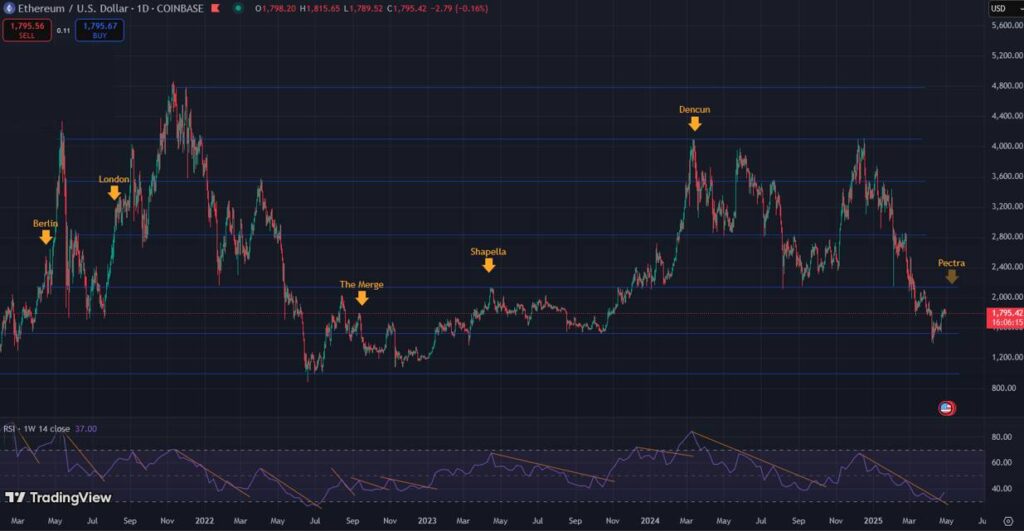The cryptocurrency landscape is buzzing with speculation as Ethereum (ETH) navigates a challenging stretch in its market performance. Despite the overall bullish trend seen in other cryptocurrencies, ETH has struggled to reclaim its former glory, lingering around $1,813 – a stark 56% decline from its recent peak. Yet, there’s a flicker of hope on the horizon with the upcoming Pectra upgrade, set to launch on May 7. This pivotal enhancement is not just an incremental update; it promises to address longstanding usability issues while boosting efficiency in staking.
Traditionally viewed as the backbone of decentralized applications, Ethereum’s challenges in scalability and user experience have given competitors like Solana and BNB room to thrive. However, Pectra introduces 11 key upgrades, including a notable proposal that allows regular user wallets to temporarily function as smart contracts. This innovation could enable easier gas fee sponsorships, making the platform more approachable for non-technical users—particularly in the realms of gaming and payments.
“Ethereum is currently experiencing one of its lowest burning periods ever, around 70 ETH per day, compared to 2,000 to 4,000 ETH in 2024.”
On the staking front, significant changes are on the horizon. With new mechanisms that allow institutional validators to hold up to 2,048 ETH, this could revitalize interest from larger entities that have recently sold off their holdings. Combined with an enhanced user experience, the Pectra upgrade aims to increase demand for ETH while potentially constraining its supply, as more tokens get locked in validator nodes.
Market data suggests a potential turning point for ETH. Recent technical indicators show that ETH may have established a local bottom, signaling a possible shift in momentum. Historically, major upgrades have led to price surges, albeit often short-lived. As Ethereum prepares for Pectra, many are closely watching to see if this will be the catalyst to reignite bullish sentiment and return ETH to its former high-flying status.
Key Takeaways on Ethereum’s Pectra Upgrade and Market Dynamics
Understanding the upcoming Pectra upgrade and its implications can help readers grasp Ethereum’s potential future and its impact on the overall crypto market:
- ETH’s Underperformance
- Currently trading at $1,813, ETH has not recovered its all-time high of $4,870 from November 2021.
- ETH has seen a 56% decline from its local peak in December 2024, underperforming compared to its peers.
- Pectra Upgrade Scheduled for May 7
- Introduces 11 Ethereum Improvement Proposals (EIPs) to enhance scalability, user experience (UX), and staking efficiency.
- The upgrade aims to address critical challenges reaffirming Ethereum’s competitive position against rivals like Solana and BNB.
- Key Features of Pectra
- EIP-7702: Allows user wallets to act like smart contracts, enabling gas payment sponsorship and non-ETH token gas fees.
- Enhanced Validator Experience: Upgrades allow institutional validators to hold more ETH (up to 2,048) and streamline onboarding processes.
- Potential Impact on ETH Price
- Improved user experience may attract new users and developers, boosting adoption and on-chain activity.
- Streamlined staking processes could encourage locking of more ETH, tightening supply and possibly raising prices.
- The current low ETH burn rate may reverse with increased activity, exerting further upward pressure on price.
- Market Sentiment and Future Prospects
- Ethereum has experienced previous upgrades that sparked brief price spikes but failed to sustain momentum due to market conditions.
- Pectra could provide the narrative and timing for ETH’s price resurgence, syncing with broader market rallies.
- The Fusaka hard fork in late 2025 adds potential for future price growth and network improvements.
Investors are encouraged to conduct thorough research and consider the potential risks associated with trading and investing in cryptocurrencies.
Analyzing the Pectra Upgrade: A Game Changer for Ethereum?
Ethereum’s recent struggles in the bull market have raised eyebrows, especially considering its inability to reclaim its previous all-time high while competitors like Solana and Binance Smart Chain continue to thrive. Yet, the upcoming Pectra upgrade could be the key to reversing ETH’s current trajectory. By positioning itself with novel features aimed at enhancing user experience and staking efficiency, Ethereum aims to regain its competitive edge in the decentralized finance (DeFi) landscape.
Competitive Advantages: One of the standout features of the Pectra upgrade is EIP-7702, which could revolutionize how users interact with the network. By enabling wallets to pay gas fees using various tokens, Ethereum significantly lowers barriers for newcomers, making it more inviting for developers and traders alike. Additionally, the amendment to the staking model—allowing institutional players to stake much larger amounts—could reignite interest among larger investors disillusioned by previous market volatility. With the changes aimed at improving user interaction and efficiency, Ethereum could see a resurgence in on-chain activity, which might ultimately uplift its market price.
Competitive Disadvantages: However, Ethereum’s historical price performance post-upgrades has often fallen short of expectations. Previous updates like the Merge and Shapella brought temporary spikes but failed to deliver sustained bullish sentiment. This raises concerns: if Pectra fails to create a lasting impact, it could lead to disillusionment among investors who have already witnessed high volatility. Moreover, Ethereum’s commitment to scalability through layer-2 solutions is still questioned by critics who believe it may not outperform more agile competitors. These factors could potentially create challenges in regaining trust and user adoption.
This narrative could particularly benefit retail investors and developers, who stand to gain from the increased usability and streamlined onboarding processes. The innovations introduced by Pectra might also foster a new wave of decentralized applications (DApps) that cater to less technical users, especially in the gaming and payment sectors. Conversely, institutional investors with heavy stakes in ETH might find themselves in uncertain waters if Pectra doesn’t deliver the expected gains. Their previous exits from ETH holdings due to past disappointments could result in liquidity challenges if sentiment shifts once again.
Ultimately, while Pectra holds promise, the broader market context and the historical performance of Ethereum upgrades are crucial factors that will determine whether this initiative can truly reposition Ethereum as a frontier leader in the world of decentralized finance.

















